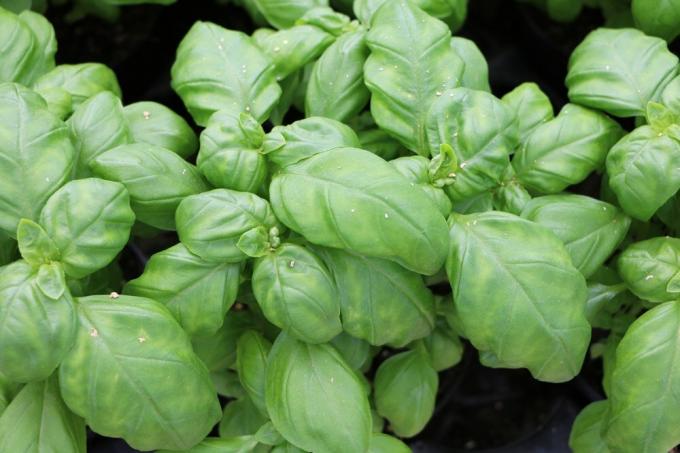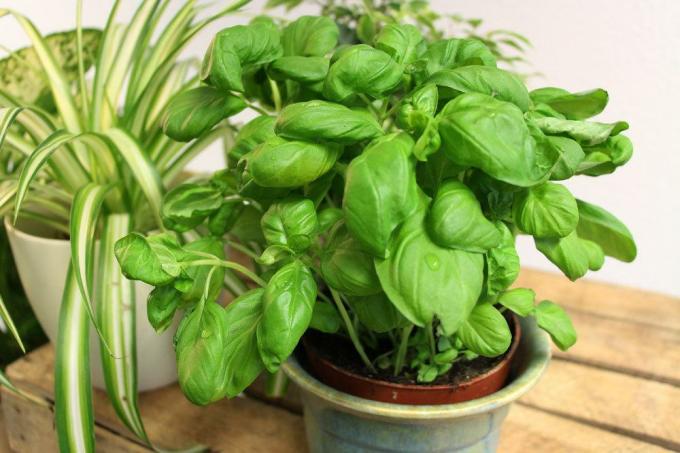
table of contents
- Hardiness
- origin
- preparation
- Thai basil species
- Hibernate - instructions
basil is probably one of the most important culinary herbs and an important part of Mediterranean cuisine. The royal herb is grown outdoors all year round in its original distribution area and enjoys sunny and warm temperatures there, which are hardly possible in Germany. Due to the popularity of the Ocimum species, many want to enjoy the fresh leaves all year round, but here the question arises: is the herb hardy?
Hardiness
Basil is not hardy
When winter arrives, Ocimum is often one of the first herbs to say goodbye to the home garden. The reason for this is the fact that no type of basil can withstand temperatures below 10 ° C really well and freezing temperatures lead quickly and irrevocably to the death of the plant. So far it has not been possible to breed a hardy taxon and therefore it is important to bring the royal herb through the winter with the right protection. The reason for the problem with basil and the cold season is the natural range of the genus, which is limited to the following regions.
- tropical Africa: this is where most of the species of the genus are at home
- tropical asia
- South America
- Central America
- southern and southeastern Europe: a large number of species have been naturalized here
- tropical australia

origin
Not a single species of the genus really comes from Europe. That classic royal herb (bot. Ocimum basilicum) is native to Africa and parts of Asia, especially India, where it is along with the Indian basil (bot. Ocimum tenuiflorum) is even used for religious purposes. The tropical homeland suggests that the genus cannot cope with the winter temperatures in Germany. In order to make this point even more clear, one must look at the location requirements of the aromatic herb.
- Light requirement: sunny
- warm with at least 12 ° C, otherwise the basil will not grow
- 20 ° C is ideal
- no rain
- no drafts
These points actually apply to all species and varieties that are available on the market and can be grown in the warmer regions of Germany in particular. Due to the need for sun and warmth, the royal herb is perfect for keeping on the balcony or terrace, as the temperatures are often higher on these. Basil plants placed in front of a house wall are especially good off because they get a lot of sun and warmth. While there are no hardy species of the plant, there are three hardy varieties of different species that can cope with a lot of rain.
- Basilicum 'Wild Purple' (bot. Ocimum canum x basilicum 'wild purple')
- Camphor Basil 'African Blue' (bot. Ocimum kilimandscharicum x basilicum 'African Blue')
- Wild basil, also called Tulsi (bot. Ocimum canum)

These three plants can easily be planted in regions in Germany that would otherwise be too humid. However, these are not winter hardy either, but they can withstand cooler temperatures a little better than the other taxa. This gives you more species and varieties that will thrive in your garden due to their resistance. They are even ideal for planting outdoors, while all other basilicum species grow better in the tub or on the balcony than in the bed. However, hibernating the plants is not a problem with a little preparation.
Tip: The three types of Thai basil Horapa (bot. Ocimum basilicum var. thyrsiflora), Maenglak (bot. Ocimum citriodorum) and Kaprao (bot. Ocimum tenuiflorum), like the three royal herbs mentioned above, are robust against rain. The aroma of the three types differs significantly from the classic kitchen basil.
preparation
In order for the royal herb to survive the cold season, some preparations must be made beforehand to make the move to winter quarters easier. If you do not have a basil at home yet, you should first select one of the types or varieties that are suitable for cultivation in Germany.
'Genoese' (bot. Ocimum basilicum 'Genovese')
- the classic type of basil and most commonly offered in Europe
Basil 'Pistou Provence' (bot. Ocimum basilicum 'Pistou Provence')
- small, round basil from France
Aniseed basil (bot. Ocimum basilicum 'Anise')
- the aroma is reminiscent of a mixture of anise and a little pepper
Basil varieties 'Dark Opal', 'Chianti', 'Moulin Rouge', 'Purple Delight'
- are red-leaved and slightly different in aroma
Thai basil species
African basil (bot. Occimum kilimanjaricum)
- quite rare, contains aromatic camphor oil
In addition to these varieties and species, you should definitely try the following variants, as these are particularly efficient for cultivation in Germany and for wintering.
- Basilicum 'Wild Pupur' (bot. Ocimum canum x basilicum 'wild purple')
- Garden basil (bot. Ocimum kilimandscharicum x basilicum)
- Russian shrub basil 'Gorbachev' (bot. Ocimum basilicum 'Gorbachev')
- African tree basil (bot. Ocimum gratissium x suave)
- Green-leaved African basil 'African Green' (bot. Ocimum kilimanscharicum basilicum 'African green')
These species and varieties are the best, perennial species that can endure winter on the window sill without any major problems. Since not all types of basil grow perennial in Germany, you have to be careful to choose a robust, perennial variant. The royal herb just keeps growing in the drops and is naturally perennial, but the extremely robust species can best be grown in the native regions. These survive the dark better than other varieties of the mint family (bot. Lamiaceae). If you are growing your Ocimum in the bed, you should make the appropriate preparations for the winter.

1. Repot all of your basil plants in separate pots filled with the appropriate substrate. This should be structured as follows.
- nutritious
- humus
- Garden soil or potting soil made from compost is ideal for this
- fresh
- wet
- well permeable
- Herbal soil should not be used as it is too lean
- pH value: 6.5 - 7.5
The pots should have drainage holes and enough space for the plants.
2. Be sure to move the plants into the living rooms as soon as the nights are only about 10 ° C to 12 ° C. This stops the growth that the plants suffer from these temperatures.
If you grow your royal herb on the balcony or terrace in buckets or pots, all you have to do is move them into the living room when it's cold.
Tip: If you want to make it easier for yourself, you should plant the plant and the pot in the bed, because then you can simply dig it out of the ground before winter. It becomes even easier if the pot has handles with which the vessel can simply be pulled out of the ground and moved to winter quarters.
Hibernate - instructions
When you have completed the preparations, there are a few points to keep in mind when wintering. The most important thing is of course the temperature, as the herbs depend on warmth.
For winter care, do the following:
1. The temperature over the entire winter should be between 18 ° C and 22 ° C. It is necessary to place the Ocimum at a window seat or in the winter garden. The place should be as sunny as possible and ideally facing south.
2. The chosen location must be protected from cold air, i.e. away from doors and windows that are frequently opened or closed. If this is not possible, you should set up a protective device, for example out of cardboard or a board.
3. Make sure that there is no waterlogging over the winter, this is dangerous for the plants.

4. Give the labiates a liquid organic fertilizer at least every four to six weeks. This keeps the basil fit over the cold season.
5. A pruning is not necessary over the winter as the plant does not develop flowers over the winter. But you can easily harvest the herb. Always cut off entire shoots at a length of five centimeters to stimulate growth.
Tip: if you cannot provide the plants with enough sunlight, you should switch to artificial light. Choose either special plant lamps with intense LEDs or growth lamps with fluorescent light and illuminate the plants for up to 12 hours a day.
